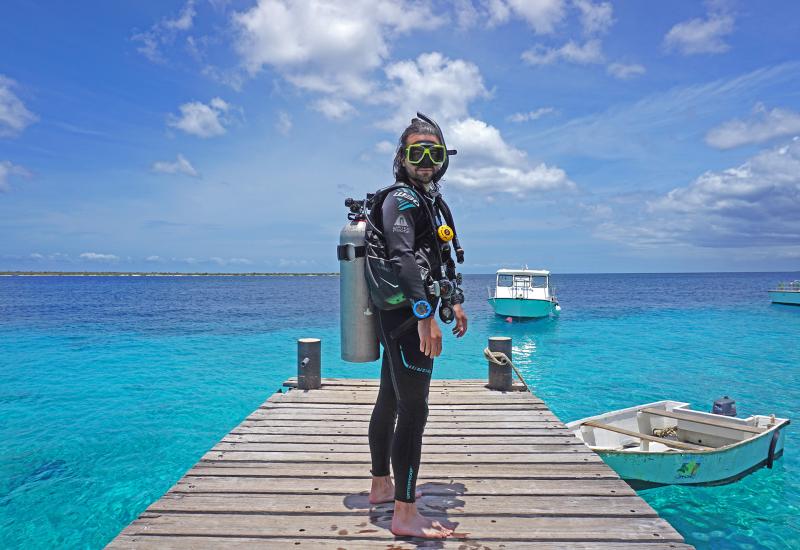Ask The Experts: Pregnancy, Mixed-Gas Diving and Becoming a Dive Pro
Q: I got certified last summer while my wife was eight months pregnant. We weren't sure if it was safe for her to dive and ultimately decided that we shouldn't risk it. I asked a lot of people about diving while pregnant, and there didn't seem to be a clear-cut answer. Can Sport Diver provide a definitive answer? — Art Schmitt, New York
A: Sport Diver can't, Art, but here's the word from Joel Dovenbarger, R.N., director of medical services for Divers Alert Network:
In the best of circumstances, recommendations are based on data — solid research that is accepted by all parties. Unfortunately, on this issue total agreement does not exist. There is no data to connect DCS (decompression sickness) to the effects of pregnancy. The bigger concern is of course AGE (arterial gas embolism — an air bubble). You only need 4 feet of water to have an incident; AGE is, however, the least common decompression-related injury.
Q: Is there something about being pregnant that could lead to AGE?
A: If you're in the water, breathing scuba, there is a risk. How big, we don't know. But pregnancy can have its side effects such as nausea commonly associated with morning sickness, delayed emptying of the stomach and increased acidity.
Q: What about a tight-fitting BC chest or waist strap? Could all of these things add up to an incident?
A: They could. Additionally, this risk is not found in the majority of the diving population, so there may well be an increased risk.
Q: What effect on the fetus? We can't really say for sure, but theoretically, any treatment or problem the mother may have, from seasickness to getting chilled, will be passed on to the fetus.''Pregnancies are for nine months, but scuba is for a lifetime. It's reasonable to wait out the pregnancy and dive without incident rather than to dive while pregnant and worry about having a problem or actually having something happen (which can randomly occur, anyway!) and blame oneself for the poor outcome.
Q: I've been interested in getting into some more serious types of diving. I've heard a lot about the different mixed-gas diving being done and wondered what the benefit of using mixed gases actually is. I've heard that it reduces decompression times. Does it? — John Bond, California
A: For your answer, John, we went to our technical diving guru, Tom Mount. Tom is head of IANTD, has well over 11,000 dives and has been diving mixed gas for over 30 years:
Let's be clear about one thing before I go on. Mixed-gas diving is not recreational diving by any stretch of the imagination. Anyone considering using trimix should complete a certification program for mixed-gas diving. Trimix, a mixture of gases typically containing nitrogen, helium and oxygen — the exact percentages of gas in the mixture vary depending on the dive plan — allows a diver to dive to greater depths than air would allow or to execute a more intermediate-depth dive where reduced narcosis is required for safety reasons. Trimix allows for the control of oxygen partial pressure (PO2), thus avoiding the risk of high oxygen exposures at depth. Using trimix has virtually no bearing on decompression time and in some cases can actually make for a longer deco. Trimix allows a diver to reduce the narcotic effects of deep diving by reducing the nitrogen content of the breathing mixture. Another benefit is that you can control the gas density, resulting in reduced work of breathing at depth. The tradeoff here is that you are also increasing your reliance on separate decompression gases, the loss of which can have dramatic effects on decompression times. Management of your decompression gases is crucial to trimix diving.
I can't emphasize this enough: Trimix should only be used by divers who need it as a tool to work safely at the depths beyond the safe range of compressed air and who have the training to do so.
Q: I'm an open-water diver and have been diving about five years. I've recently thought about becoming an instructor. What's involved and what are my chances of employment? — Bob Lawrence, Colorado
A: We asked Colorado-based Scuba Schools International to answer your question, Bob, and here's the answer from Dennis Pulley, SSI training manager:
I am glad to hear you are actively diving and are interested in continuing with your diving knowledge. The next step in becoming an instructor is to complete your Advanced and Rescue training. You will also need to complete CPR and First Aid training as well. You'll also need experience and training in various specialty areas such as deep diving and navigation. The dive leader training in some agencies is divided into two courses: Divemaster and Assistant Instructor. With other agencies, it is offered as a single course. This program will take from one week to one year to complete, depending on the structure of the program. The cost can run between $400 and $800. You will need a medical evaluation signed by a physician clearing you to dive before you can receive this certification. Becoming an instructor will take between seven to 10 days and a year, again depending on the structure and scheduling of the class. Costs vary. The chances of gaining employment are good, depending on where you want to locate. To find a reputable training facility, I would suggest visiting a number of dealers, talking to the individuals who will be conducting the training and speaking to others who have taken this training. Good luck.
Have a question? Send it to [email protected] and if we can't answer it, we'll forward it to an expert who can.










